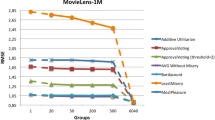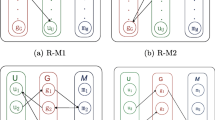Abstract
Recommender systems recommend items to users that would suit the users’ preferences. Suggesting personalized items in the context of a group of users is a non-trivial task. The increasing popularity of group recommender systems in recent years attracted researchers to compute the consensus among the group members more accurately. A recommendation is possible by aggregating the user preferences of the group. The composition of a group plays a significant role in group recommendation. As grouping is an unsupervised task, it becomes essential to form groups from the available information where each group member shares some common characteristics. In this paper, we have blended one permutation hashing and autoencoder techniques to auto-detect the groups. We use both methods very effectively to form the groups. We establish the efficacy of the proposed model in the order and flexible size preference models. We conducted experiments on real-world datasets and found that the proposed method is an efficient and robust approach to form a group automatically.













Similar content being viewed by others
Notes
Group budget or space budget is the maximum number of items that can be recommended in a group recommendation.
A reduced representation of a characteristic matrix after applying minhash technique.
In the given an example, \(c=\lceil \frac{3}{2}\rceil +1=3\).
References
Agarwal A, Chakraborty M, Chowdary R (2017) Does order matter? effect of order in group recommendation. Expert Syst Appl 82:115–127
Aytekin AM, Aytekin T (2019) Real-time recommendation with locality sensitive hashing. Journal of Intelligent Information Systems 53(1):1–26
Nozari RB, Koohi H (2020) A novel group recommender system based on members’ influence and leader impact. Knowl-Based Syst 205:106296
Basu Roy S, Lakshmanan LVS, Liu, R (2015) From group recommendations to group formation. In: Proceedings of the 2015 ACM SIGMOD International Conference on Management of Data, SIGMOD ’15, New York, NY, USA, ACM, pp 1603–1616
Birtolo C, Ronca D (2013) Advances in clustering collaborative filtering by means of fuzzy c-means and trust. Expert Syst Appl 40(17):6997–7009
Blondel VD, Guillaume J-L, Lambiotte R, Lefebvre E (2008) Fast unfolding of communities in large networks. J Stat Mech: Theory Exp 2008(10):P10008
Boratto L, Carta S (2015) The rating prediction task in a group recommender system that automatically detects groups: architectures, algorithms, and performance evaluation. Journal of Intelligent Information Systems 45(2):221–245
Boratto L, Carta S, Fenu G (2017) Investigating the role of the rating prediction task in granularity-based group recommender systems and big data scenarios. Inf Sci 378:424–443
Cantador I, Castells P (2011) Extracting multilayered communities of interest from semantic user profiles: Application to group modeling and hybrid recommendations. Comput Hum Behav 27(4):1321–1336 (Social and Humanistic Computing for the Knowledge Society)
Cao D, He X, Miao L, An Y, Yang C, Hong R (2018) Attentive group recommendation. In: The 41st International ACM SIGIR Conference on Research & Development in Information Retrieval, SIGIR ’18, New York, NY, USA, ACM pp 645–654
Choudhary N, Minz S, Bharadwaj KK (2020) Negotiation framework for group recommendation based on fuzzy computational model of trust and distrust. Multimedia Tools and Applications 79(37):27337–27364
Covington P, Adams J, Sargin E (2016) Deep neural networks for youtube recommendations. In: Proceedings of the 10th ACM Conference on Recommender Systems, RecSys ’16, New York, NY, USA. Association for Computing Machinery , pp 191-198
da Costa AF, Manzato MG, Campello, RJGB (2016) Group-based collaborative filtering supported by multiple users’ feedback to improve personalized ranking. In: Proceedings of the 22nd Brazilian Symposium on Multimedia and the Web, Webmedia ’16, pp 279-286, New York, NY, USA, Association for Computing Machinery
Dara S, Ravindranath Chowdary C (2019) A study on the role of flexible preferences in group recommendations. Appl Intell 49(9):3293–3307
Dara S, Chowdary CR, Kumar C (2019) A survey on group recommender systems. Journal of Intelligent Information Systems 54(2):271–295
Hassanian-esfahani R, Kargar M (2018) Sectional minhash for near-duplicate detection. Expert Syst Appl 99:203–212
He X, Liao L, Zhang H, Nie L, Hu X, Chua TS (2017) Neural collaborative filtering. In: Proceedings of the 26th International Conference on World Wide Web, WWW ’17, pp 173-182, Republic and Canton of Geneva, CHE, International World Wide Web Conferences Steering Committee
Jhamb Y , Ebesu T, Fang Y (2018) Attentive contextual denoising autoencoder for recommendation. In: Proceedings of the 2018 ACM SIGIR International Conference on Theory of Information Retrieval, ICTIR ’18, pp 27-34, New York, NY, USA. Association for Computing Machinery
Jiang J, Li W, Dong A, Gou Q, Luo X (2020) A fast deep autoencoder for high-dimensional and sparse matrices in recommender systems. Neurocomputing 412:381–391
Kaya M, Bridge DG, Tintarev N (2020) Ensuring fairness in group recommendations by rank-sensitive balancing of relevance. In: Santos RLT, Marinho LB, Daly EM, Chen L, Falk K, Koenigstein N, de Moura ES (eds) RecSys 2020: Fourteenth ACM Conference on Recommender Systems, Virtual Event, Brazil, September 22-26, 2020, pp 101–110. ACM
Kumar C, Chowdary CR (2022) A study on the role of uninterested items in group recommendations. Electr Comm Re. https://doi.org/10.1007/s10660-021-09526-4
Kumar C, Chowdary R, Shukla D (2022) Automatically detecting groups using locality-sensitive hashing in group recommendations. Inf Sci 601:207–223
Li X, She J (2017) Collaborative variational autoencoder for recommender systems. In: Proceedings of the 23rd ACM SIGKDD International Conference on Knowledge Discovery and Data Mining, KDD ’17, pp 305-314, New York, NY, USA. Association for Computing Machinery
Ma G, Wang Y, Zheng X, Miao X, Liang Q (2021) A trust-aware latent space mapping approach for cross-domain recommendation. Neurocomputing 431:100–110
Masthoff J (2011) Group Recommender Systems: Combining Individual Models. Springer, US, Boston, MA, pp 677–702
Ntoutsi E, Stefanidis K, Nørvåg K, Kriegel H-P (2012) Fast group recommendations by applying user clustering. In: Atzeni P, Cheung D, Ram S (eds) Conceptual Modeling. Springer, Berlin, Heidelberg, pp 126–140
Ntoutsi E, Stefanidis K, Rausch K, Kriegel HP (2014) "strength lies in differences": Diversifying friends for recommendations through subspace clustering. In: Proceedings of the 23rd ACM International Conference on Conference on Information and Knowledge Management, CIKM ’14, pp 729-738, New York, NY, USA. Association for Computing Machinery
Ortega F, Hernando A, Bobadilla J, Kang JH (2016) Recommending items to group of users using matrix factorization based collaborative filtering. Inf Sci 345(C):313–324
Palomares I, Porcel C, Pizzato L, Guy I, Herrera-Viedma E (2021) Reciprocal recommender systems: Analysis of state-of-art literature, challenges and opportunities towards social recommendation. Information Fusion 69:103–127
Pan Y, He F, Haiping Yu (2019) A novel enhanced collaborative autoencoder with knowledge distillation for top-n recommender systems. Neurocomputing 332:137–148
Pulgar FJ, Charte F, Rivera AJ, del Jesus MJ (2020) Choosing the proper autoencoder for feature fusion based on data complexity and classifiers: Analysis, tips and guidelines. Information Fusion 54:44–60
Qin D, Zhou X, Chen L, Huang G, Zhang Y (2018) Dynamic connection-based social group recommendation. IEEE Transactions on Knowledge and Data Engineering, pp 1–1
Rendle S, Krichene W, Zhang L, Anderson J (2020) Neural collaborative filtering vs. matrix factorization revisited. RecSys ’20, page 240-248, New York, NY, USA. Association for Computing Machinery
Sankar A, Wu Y, Wu Y, Zhang W, Yang H, Sundaram H (2020) Groupim: A mutual information maximization framework for neural group recommendation. In: Proceedings of the 43rd International ACM SIGIR Conference on Research and Development in Information Retrieval, SIGIR ’20, pp 1279-1288, New York, NY, USA. Association for Computing Machinery
Shi X, Luo X, Shang M, Liang G (2017) Long-term performance of collaborative filtering based recommenders in temporally evolving systems. Neurocomputing 267:635–643
Shrivastava A, Li, P (2014) Densifying one permutation hashing via rotation for fast near neighbor search. In: Proceedings of the 31st International Conference on International Conference on Machine Learning - Volume 32, ICML’14, pp I-557-I-565. JMLR.org
Shrivastava A, Li P (2014) Improved densification of one permutation hashing. In: Proceedings of the Thirtieth Conference on Uncertainty in Artificial Intelligence, UAI’14, page 732-741, Arlington, Virginia, USA, AUAI Press
Sourabh V, Ravindranath Chowdary C (2019) Peer recommendation in dynamic attributed graphs. Expert Syst Appl 120:335–345
Stratigi M, Pitoura E, Nummenmaa J, Stefanidis K (2021) Sequential group recommendations based on satisfaction and disagreement scores. Journal of Intelligent Information Systems, pages 1–28
Subbian K, Aggarwal C, Hegde K (2016) Recommendations for streaming data. In: Proceedings of the 25th ACM International on Conference on Information and Knowledge Management, pages 2185–2190. ACM
Symeonidis P, Janes A, Chaltsev D, Giuliani P, Morandini D, Unterhuber A, Coba L, Zanker M (2020) Recommending the video to watch next: An offline and online evaluation at youtv.de. In: Santos RLT, Marinho LB, Daly EM, Chen L, Falk K, Koenigstein N, de Moura ES, (eds) RecSys 2020: Fourteenth ACM Conference on Recommender Systems, Virtual Event, Brazil, September 22-26, 2020, pages 299–308. ACM
Tran TNT, Felfernig A, Trattner C, Holzinger A (2020) Recommender systems in the healthcare domain: state-of-the-art and research issues. Journal of Intelligent Information Systems, pp 1–31
Wang H, Wang N, Yeung D-Y (2015) Collaborative deep learning for recommender systems. In: Proceedings of the 21th ACM SIGKDD International Conference on Knowledge Discovery and Data Mining, KDD ’15, page 1235-1244, New York, NY, USA. Association for Computing Machinery
Wehrli S (2013) Set similarity with b-bit k-permutation minwise hashing. Algorithms for Database Systems, ETH Zurich
Yalcin E, Ismailoglu F, Bilge A (2021) An entropy empowered hybridized aggregation technique for group recommender systems. Expert Syst Appl 166:114111
Ye M, Liu X, Lee WC (2012) Exploring social influence for recommendation: A generative model approach. In: Proceedings of the 35th International ACM SIGIR Conference on Research and Development in Information Retrieval, SIGIR ’12, page 671-680, New York, NY, USA. Association for Computing Machinery
Zhang G, Liu Y, Jin X (2020) A survey of autoencoder-based recommender systems. Front Comp Sci 14:430–450
Acknowledgements
The support and the resources provided by PARAM Shivay Facility under the National Supercomputing Mission, Government of India at the Indian Institute of Technology, Varanasi are gratefully acknowledged.
Author information
Authors and Affiliations
Corresponding author
Additional information
Publisher's Note
Springer Nature remains neutral with regard to jurisdictional claims in published maps and institutional affiliations.
Rights and permissions
About this article
Cite this article
Kumar, C., Chowdary, C.R. OPHAencoder: An unsupervised approach to identify groups in group recommendations. Computing 104, 2635–2657 (2022). https://doi.org/10.1007/s00607-022-01103-3
Received:
Accepted:
Published:
Issue Date:
DOI: https://doi.org/10.1007/s00607-022-01103-3
Keywords
- Group recommender systems
- One permutation hashing
- Autoencoder
- Order user preferences
- Flexible-size preferences




